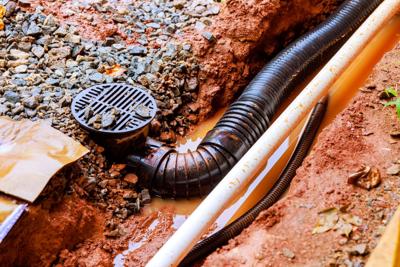
Drainage trench used for communications cables is inundated with water during periods of heavy rainfall
When you think of plumbing issues, clogged drains or leaky faucets might come to mind. But one of the most critical—and often overlooked—services a plumber performs is a sewer line inspection. Whether you're buying a new home, dealing with persistent backups, or just being proactive, understanding what happens during this process can save you time, money, and headaches.
In this article, we’ll take you behind the scenes of a professional sewer inspection, explaining the tools plumbers use, common problems they find, and why this service is so important for homeowners.
Why Sewer Line Inspections Matter
Sewer lines are buried underground, making them "out of sight, out of mind"—until something goes wrong. A damaged or clogged sewer line can lead to:
Foul odors in your yard or home
Slow drains throughout the house
Sewage backups (the worst-case scenario)
Foundation damage from leaking pipes
A professional inspection helps catch problems early before they turn into expensive disasters.
How Plumbers Inspect Sewer Lines
Gone are the days of guesswork—modern plumbers use advanced technology to inspect sewer lines. Here’s how it works:
1. Locating the Cleanout Access Point
Before any inspection begins, the plumber will locate the cleanout, a pipe that provides direct access to the sewer line. If your home doesn’t have one, they may need to remove a toilet or use a roof vent.
2. Inserting a Sewer Camera
The star of the show is a flexible, waterproof inspection camera attached to a long cable. This high-resolution camera sends real-time video to a monitor, allowing the plumber to see inside the pipes.
3. Navigating the Sewer Line
As the camera travels through the pipes, the plumber looks for:
Cracks or breaks (from shifting soil or tree roots)
Corrosion (common in older metal pipes)
Bellied pipes (sagging sections that trap waste)
Blockages (from grease, debris, or invasive roots)
4. Recording & Reporting Findings
The inspection is recorded, and the plumber provides a detailed report with:
Video footage of the inside of your pipes
A map of problem areas
Recommended repairs (if needed)
Common Problems Found During Sewer Inspections
1. Tree Root Intrusions
Roots seek moisture and can infiltrate even small pipe cracks, causing major blockages.
2. Pipe Corrosion (Older Homes)
Cast iron or clay pipes deteriorate over time, leading to collapses.
3. Grease & Debris Buildup
Fats, oils, and non-flushable items (like "flushable" wipes) create stubborn clogs.
4. Misaligned or Collapsed Pipes
Ground movement or poor installation can cause pipes to shift and fail.
What Happens After the Inspection?
Depending on the findings, your plumber may recommend:
Hydro jetting (high-pressure water cleaning)
Spot repairs (fixing a small damaged section)
Pipe relining (a trenchless repair method)
Full sewer line replacement (for severely damaged pipes)
How Often Should You Get a Sewer Inspection?
Before buying a home (avoid costly surprises)
Every 1-2 years for older homes
If you notice slow drains or backups
A sewer line inspection might not be glamorous, but it’s one of the smartest ways to protect your home. By hiring professional plumbers to inspect your pipes, you avoid emergencies and make informed decisions about repairs.
Need a sewer inspection? Don’t wait for a disaster—schedule one today with a trusted plumber in your area!



(0) comments
Welcome to the discussion.
Log In
Post a comment as Guest
Keep it Clean. Please avoid obscene, vulgar, lewd, racist or sexually-oriented language.
PLEASE TURN OFF YOUR CAPS LOCK.
Don't Threaten. Threats of harming another person will not be tolerated.
Be Truthful. Don't knowingly lie about anyone or anything.
Be Nice. No racism, sexism or any sort of -ism that is degrading to another person.
Be Proactive. Use the 'Report' link on each comment to let us know of abusive posts.
Share with Us. We'd love to hear eyewitness accounts, the history behind an article.